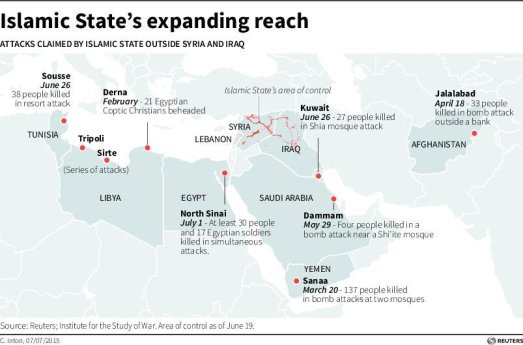How the Dominoes Will Fall After ISIS Takes Damascus
For more than four years, the Assad regime in Syria has resisted its people's cry to be freed from dictatorship.
During the last several weeks, the Assad regime has shown signs of vulnerability punctuated by a weakened relationship with Iran. Iranian advisers who had supported Assad for years are now consumed with supporting the Iraqi government in its war against ISIS and the Houthis in Yemen in their war against a Saudi-led coalition of Arab nations. Iran's economy has been damaged severely after a decade of international sanctions and Iran cannot support the Syrian regime financially forever. Hezbollah, the best trained force fighting for the regime, has lost about a thousand of its best fighters in Syria, the very fighters desperately needed to fight ISIS and al-Qaeda in Lebanon.
For these reasons, Syrian government forces have suffered a series of defeats over the last weeks. The Assad regime now controls no more than 35 percent of the country, leaving the rest to ISIS, the Kurds and the other rebel groups like al-Nusra front. Allepo, Syria's largest city is almost surrounded completely by the rebels. The Syrian Kurds have increased the territories they control in the north to include most of the border areas with Turkey. Assad is also the de facto mayor of Damascus and the coastal areas. If this trend continues, which is likely to happen, the Syrian regime will probably fall by the end of this year. The two competing forces to occupy Damascus are ISIS and al-Nusra front.
If either of these two terrorist organizations capture Damascus, the world will witness an unprecedented chain reaction. It would be the first time that al-Qaeda or ISIS controlled a national capital. “ISIS's strategic target is to control one of the historical capitals of the Islamic caliphates: Damascus, Baghdad or Samarra. These cities are very symbolic for its followers,” says Hisham al-Hashimi, an expert on ISIS and the author of the book, The World of ISIS.
A possible scenario for the aftermath of the fall of Damascus is the infighting between these two terror groups. If that happens or a new civil war breaks out, the region and the world would be spared an imminent and great danger. But if that infighting doesn’t take place, the world needs to prepare for continued genocides and years of terrorist acts across the continents. The Assads, who have ruled Syria since 1970, are Alawaites — a version of Shiite Islam and a faith that serves 12 percent of the Syrian people. With Russia's diplomatic aid and arms, Iran's economic and military advice, Lebanese Hezbollah and other Shiite Iraqi and Afghan fighters and the use of chemical weapons against its own people, the Assad regime has prevailed. Until now.
After the fall of the Assad regime, the Syrian people's different ethnic and sectarian components would cause the society to fray further. “Imagine that you wake up one day to find out that the ruling party in Damascus is no longer the Arab Baath Socialist Party; it is al-Nusra front.... Imagine you wake up to hear that another caliph has appeared somewhere else.... I say to those who complain about what is going on in our region: you haven't seen anything yet. Civil wars don't end suddenly, unless there is a victory that left many massacred,” says Harith Hasan, a fellow at the Radcliffe Institute for Advanced Studies at Harvard University who is researching ethnic violence and identity in the Middle East.
While Syria's Sunnis were the driving force of the Syrian rebels, the other 40 percent of the Syrian people supported the regime. They include Alawite, Christians, Druze, Kurds and others. There is no doubt that the Alawites will suffer the revenge of those whom they suppressed for a half century. “There is a very large revenge between the Sunnis and the Alawite after what the Alawite have done to the Sunnis, which includes killing, torture, displacement and raping of women....We think that Alawite is a sect that has left the religion of Allah and Islam,” said Abu Mohammed al-Julani, the leader of al-Nusra front in a rare TV interview. He added that Christians are supporting the regime.
Julani's remarks were supported by the massacre of at least 30 Druze by his fighters in Idlib last month. In Qalb Lawza, one of the Druze villages in Idlib, the al-Nusra Front earlier this year forced inhabitants to renounce their faith and accept Sunni Islam. Al-Nusra destroyed Druze shrines and made residents abide by their regulations, such as gender segregation. “These impositions have notbeen cancelled and remain in force to this day,” says Aymenn Jawad Al-Tamimi, a Shillman-Ginsburg Fellow at the Middle East Forum.
The very likely persecution of Syria's minorities under an extreme Sunni Islamic rule enforced by ISIS or al-Nusra front will result in millions of refugees and thousands of people killed, tortured and enslaved. With more than 60 million refugees already displaced by wars, millions more could cause the world relief system to collapse.
How the Dominoes May Fall
Israel: The fate of the Druze has been a main source of debate in Israel. Should Israel depart from its neutral stand regarding the Syrian civil war? Many Druze serving in the Israeli army are pushing for Israeli intervention in Syria to protect the Druze there. But Israel would have to deal for the first time in its history with a neighboring country in an official state of war to confront either al-Qaeda or ISIS or both. If those two groups do not fight each other, it is likely they would fight Israel to take back the Golan Heights that Israel occupied in the 1967 war with the Arabs.
Lebanon:
The country most affected by the fall of the Assad regime would be Lebanon. Hezbollah, the militant Shiite group supported by Iran, has controlled the country since the withdrawal of the Syrian army in 2005. Lebanon's Sunnis, Christians and Druze have resisted Hezbollah domination ever since.
But none of these groups was ever a serious challenger to the well-trained and armed Shiite group. Should the regime in Syria be toppled by ISIS and al-Nusra, Lebanon may face civil war similar to the conflicts in1975 and 1989. “The removal of the Assad regime
means the automatic removal of Hezbollah.... Hezbollah realizes that its battle with us [the Syrian rebels] is lost. But it is obligated to fight in this battle to the end to extend the reign of the regime that is supporting it,” added al-Julani.
Iraq: The other country that will suffer the consequences of the fall of the Assad regime is Iraq. With a Sunni-ruled Syria, ISIS and the other Sunni militant groups in Iraq will be encouraged and supported by Syria, which would prolong the civil war in Iraq.
Turkey and Jordan: Turkey will be tempted to interfere in Syria as well. The fall of the Assad regime would make the partial autonomy that the Syrian Kurds now enjoy more feasible. The Turkish leadership has never been happy with the gains of the Iraqi and the Syrian Kurds because it feared that these gains would make its own Kurds bolder in their demands for self-rule. Because of this, Turkey has viewed ISIS as the lesser of two evils. It has considered establishing a security zone on the border with Syria to support the Syrian rebels and to curb Kurdish ambitions of independence.
Until now, Turkey's blind eye toward al-Qaeda and ISIS has kept the terror groups from mobilizing the grassroots in Turkey. Yet, a change in official policy would likely mean that the groups would target Turkey as a new recruiting field. The same would likely apply in Jordan.
Global Terrorism: The most alarming reaction to the fall of Damascus to ISIS would be a shockwave of multiple terrorist plots all over the world. Last month, we passed the one-year anniversary of the capture of Mosul, Iraq's second largest city. In that time, ISIS has dominated its mother organization, al-Qaeda, and secured the allegiance of more than 60 worldwide terror organizations.
This organizational change has transformed the local Syrian militia into a terrorist network with a record of attacks in Texas, Paris, Tunisia, Libya, Egypt, Nigeria, Niger, Chad, Cameron, Lebanon, Saudi Arabia, Yemen, Kuwait and Afghanistan. ISIS is engaged in ground wars with the governments of Iraq, Syria, Egypt, Libya, Nigeria, Cameron, Niger and Chad and is subjected to air raids by a U.S.-led coalition that includes 60 nations. Despite this, ISIS achieved another strategic victory when it captured the city of Ramadi, the capital of Iraq's largest province last May.
This record of attacks and plots will become a minor issue if and when ISIS captures Damascus. ISIS operatives and plots will multiply. If ISIS counts tens of thousands of members now, it soon would reach hundreds of thousands. Instead of uploading one propaganda video daily and tweets that reach tens of thousands of Twitter followers, it could increase its reach tenfold.
The Myth That’s Compelling ISISLike several other religions, many Muslims believe in an end of time scenario that involves the emergence of a redeemer called al-Mahdi who will rule the world for seven to 19 years and fill it with justice after it was filled with injustice. Al-Mahdi — Arabic for “the guided one” — was never mentioned in the Quran, but some claim that the prophet Mohammed prophesied about him. While many Sunnis — who make up to 85 percent of Muslims — believe that al-Mahdi hasn't been born yet, most Shiites believe that al-Mahdi is the 12th Imam and the descendent of the prophet Mohammed who disappeared in Iraq in 874 A.D.
It is believed that his emergence, or re-emergence, will be the final chapter before the end of time and judgment day. With some oversimplification, the story suggests that al-Mahdi will lead the camp of the righteous against the camp of evil. Jesus — whose soul Muslims believe was saved by God before the crucifixion — will descend from the sky to Damascus and declare his allegiance to al-Mahdi.
Against the army led by al-Mahdi and Jesus, the camp of evil will have two leaders. A tyrant appears in Damascus called al-Sufyani and an equivalent of the Christian Antichrist called “the one-eyed deceiver” appears in the border area between Afghanistan, Iran and Turkmenistan. Al-Mahdi will appear in Mecca, Saudi Arabia. A war will start that involves the capture of Istanbul and a final battle in a place called Dabiq in northern Syria. ISIS and al-Qaeda believe fully in this final battle. ISIS has chosen the name Dabiq for its online magazine. Al-Mahdi soldiers will be tall, with long black hair and beards, dressed in black and carry the prophet’s black banner, the rationale for ISIS's and al-Qaeda’s choice of these figures in their propaganda videos.
“After the battle of Damascus, I expect that the rhetoric of the caliphate state addressed to the Sunnis of the world will shift from the sectarian provocation to the al-Mahdism narrative...this shift will capture a large part of the attention and the imagination of a Middle East that is so easy to persuade with conspiracy theories and fantasies.... Both the Sunni and Shiite common audiences are prepared to receive these Mahdisim calls...accordingly, we will witness a surge of madness that may last for a period of time and may inflame a great war. These are desperate nations awaiting the magical salvation. They sit on excessive arms and munition and they stand on important international power and transportation lines. Someone will come and tell them -- hurry up and make a stand. The end of time has approached,” says Nibras al-Kadhimi, the fellow at Hudson Institute who is researching the Mahdi phenomenon.
A friend of al-Kadhimi’s on Facebook asked him, “anywhere to escape this madness?” Al-Kadhimi replied, “The south pole. It doesn’t show on the ISIS's world map of its five Dinar currency. See you there!”
Top Reads fr




No comments:
Post a Comment
Thanks for commenting. Your comments are needed for helping to improve the discussion.